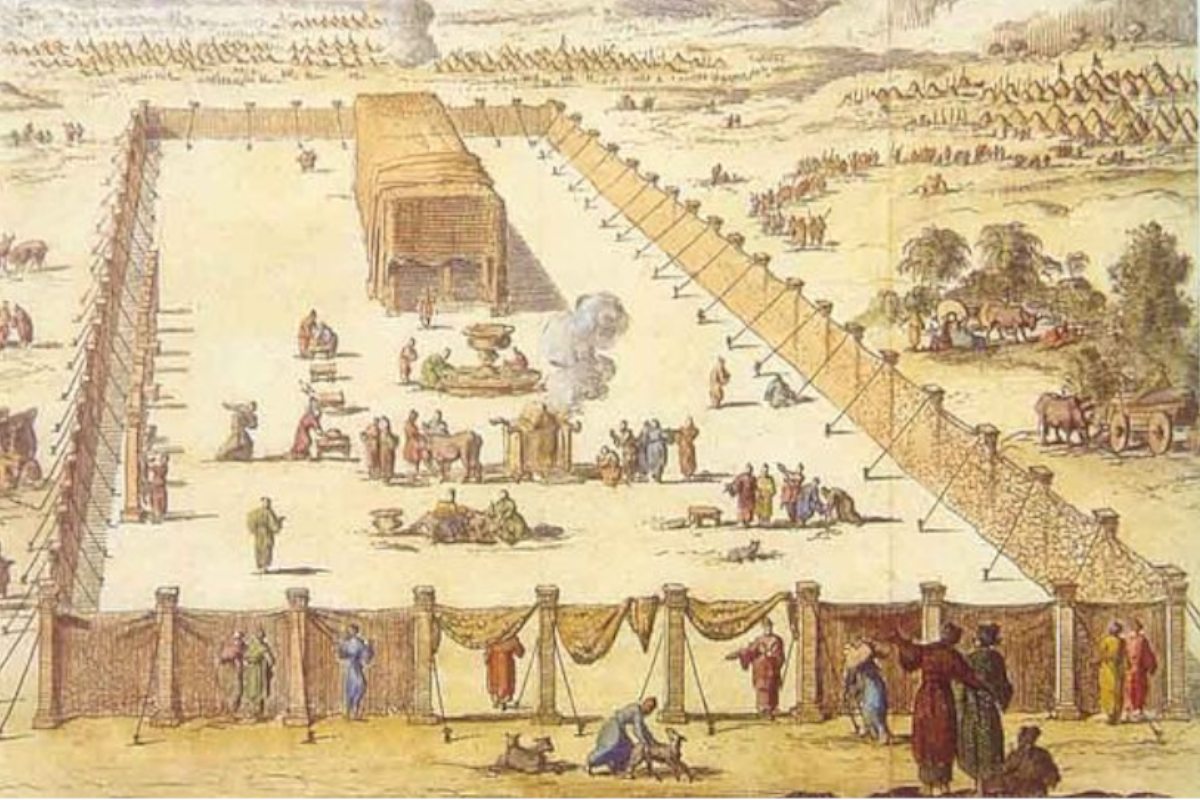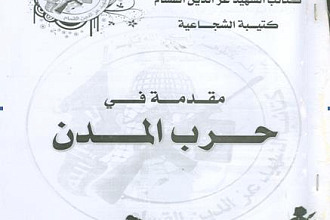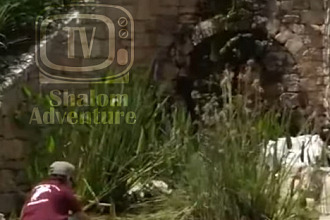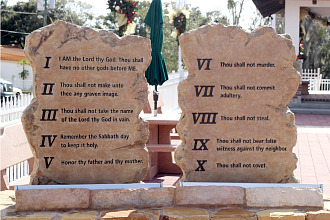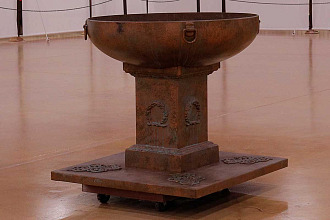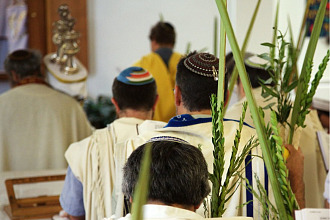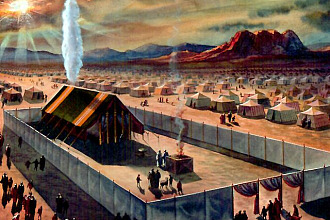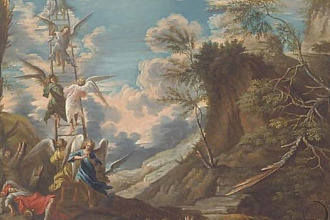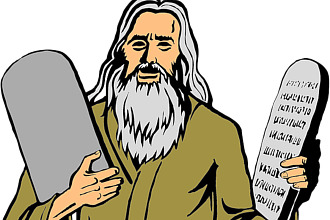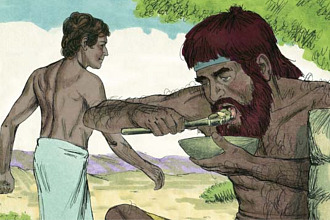Parasha for the Week: Terumah: Exodus 25:1 - 27:19.
Haftarah for the Week: 1 Kings 5:12 - 6:13.
Apostolic Writings: Revelation 15.
Overview
G-d commands Moshe to build a Mishkan (Sanctuary) and supplies him with detailed instructions. The Children of Israel are asked to contribute precious metals and stones, fabrics, skins, oil and spices.
Description of the Mishkan
- In the Mishkan’s outer courtyard are an altar for the burnt offerings and a laver.
- The Tent of Meeting is divided by a curtain into two chambers.
- The outer chamber is accessible only to the kohanim (priests), the descendants of Aharon. This contains the table of showbread, the menorah, and the golden altar for incense.
- The innermost chamber, the Holy of Holies, may be entered only by the kohen gadol (high priest), and only once a year, on Yom Kippur. Here is the Ark that held the Ten Commandments inscribed on the two tablets of stone that G-d gave to the Jewish nation on Mount Sinai. All of the utensils and vessels, as well as the construction of the Mishkan (sanctuary), are described in great detail.
God's Plan of Salvation
The five Parashot, beginning with this week’s Parashah, Terumah, to the end of the book of Exodus, are very important to understand God’s plan of salvation for human beings. These chapters of Exodus describe the Mishkan “sanctuary” -- the Tabernacle, or a miniature of the Temple -- in the desert. We have the beginning of the dedication of the sanctuary in chapter 40 of Exodus, which will be completed in the book of Leviticus. It took about 2 years for Israel to build the Mishkan; it served them as a place of worship during their forty years in the wilderness, until they entered into the land of Israel, where according to the Jewish tradition they built a more permanent house of worship, even though the main furniture was still portable. And according to the text of the Haftarah, the temple of Jerusalem would be built about four hundred eighty years later by king Solomon, even though everything was prepared by King David.
Great and expensive preparations were necessary to build the sanctuary, and that is why a large amount of the most precious and costly material was required. Yet the Almighty accepted only freewill offerings, “Hashem said to Moses, ‘Speak to the people of Israel, that they take for me a contribution (terumah). From every man whose heart moves him you shall receive the contribution for me [terumati]” (Exodus 25:1–2). Why does the Torah say, “take for me a contribution?” God should have told Moshe to tell the people, “that they shall give for Me an offering?” We have, in this verse, the word terumah twice, which is translated by “contribution” but means “offering” The first one says Le-terumah “an offering for me” and the second one says: Et-terumati which means literally “my offering.” It is important to understand first that in this text, it is about “offering” and not about “tithes.” There are people who give tithes, and they consider that it is enough -- they have contributed enough to the cause of God and can use all the rest of the money in their possession for themselves; but according to the Bible, God is expecting not only tithes but also offerings from us.
A Dwelling Place
The Torah affirms that God said to Moshe “And they shall make Me a sanctuary so that I shall dwell among them” (Exodus 25:8). A legitimate question is asked here: Why build a Sanctuary? The purpose of the Sanctuary is very important and integral in God’s plan. From the beginning (Bereishit), God wanted to dwell with his people. In fact, we discover in history that God wanted to dwell among his people three times: in Gan Eden with Adam and Eve; in the wilderness; among the people of Israel; and at the time of His incarnation as Yeshua HaMashiach.
In the Gan Eden there was no separation between God and his creation. He was able to speak with Adam and Eve as fathers and children speak together. But by their sin and disobedience, Adam and Eve broke this relationship. The consequences were that men could not live anymore in the Gan Eden and could not have this direct relationship with their Creator. However, God pursues this goal, to be able to dwell among His people. This purpose could not be achieved without saving men and women from death. He established a plan of salvation in order to bring back this relationship between God and humans.
All of the Plan of Salvation is illustrated in the sanctuary. It is the second time God dwelled among his people. God used this illustration and this way because of the sinful nature of humanity. Because of this sinful nature, we can no longer see God as Adam and Eve could see Him in the Gan Eden; that is why God said to Moses that no human being can “see” Him and remain alive. The mystery of the mishkan (sanctuary) is part of that quest to see Him and to understand how to re-establish our relationship with our Creator. That is why the manner in which the sanctuary was organized, the material used, the daily and annual services, the biblical feasts, the individual sacrifices, all symbolically represent God’s love and his plan of salvation.
The third time God wanted to dwell among his people was at the incarnation of Yeshua on the earth. Yochanan affirms “In the beginning was the Word. The Word was with God, and the Word was God. He was with God in the beginning. All things were made through Him, and apart from Him nothing was made that has come into being. In Him was life, and the life was the light of men” (John 1:1–4) and then describes the incarnation of the Word in this way: “And the Word became flesh and tabernacled among us. We looked upon His glory, the glory of the one and only from the Father, full of grace and truth.” (John 1:14). That is why it is so important to study all that is in connection with the sanctuary and to understand the meaning of the symbols used in it.
Haftarah: 1Kings 5:12 - 6:13
Our Haftarah starts in the verse 12 in most translations and in verse 26 in Hebrew. The preceding verses speak about the relations between Hiram and Solomon. Hiram was king of the city-states of Tyre and Sidon on the Mediterranean coast, in present Lebanon. Hiram was a faithful friend of King David and sent a large shipment of cedar wood and some carpenters to build David’s Palace (cf. 2 Samuel 5). Thus, in this chapter, Hiram offers to help Solomon with anything. Solomon accepts his help and asks him help to build the Temple in Jerusalem.
In verse 12 [26] the text repeats that Solomon was blessed by the spiritual gift of wisdom, “God gave Solomon wisdom and discernment in great measure, and a breadth of understanding as vast as the sand on the seashore” (1 Kings 5:9-14 [29]).
Solomon knew that it was not good for anyone to be away from their family; that is why the preparation of the building of the Temple would be in the present day Lebanon where the Cedar trees are. He sent ten thousand men every ten days. Each group of ten thousand worked for ten days in Lebanon and stayed at home for the rest of the month. Even though Hiram sent his carpenters to prepare the wood for the building, Solomon wanted to participate and sent his Jewish workers too. However, the preparation of this building was not made only of cedar wood, but also of stones: “Solomon had 70,000 porters, and 80,000 stonecutters in the mountains, besides Solomon’s chief officers that were over the work -- 3,300 who supervised the people who were doing the work. Then the king commanded, and they quarried great stones, costly stones, to lay the foundation of the House with cut stones. So Solomon’s builders and Hiram’s builders along with the Gebalites cut them, and prepared the timber and the stones to build the Hous.” (1 Kings 5:29–32 [15–18]).
The Wilderness’ Sanctuary was used by Israel for about four hundred eighty years before Solomon built the Temple in Jerusalem (1 Kings 6:1). Let’s try a chronology of Israel between the Exodus and the building of the Temple. We believe that the Exodus was in the fifteenth century BCE, between 1445 and 1441 BCE. Thus, four hundred and eighty years later would be 965-961 BCE. David was king around the year 1000 BCE. The month of Ziv mentioned in this verse is the current month of Iyar or May. It was a good month to start the building of the Temple, because it is a dry season, thus the mortar would dry quickly.
Then we have the dimensions of the Temple of Salomon: “60 cubits long, 20 cubits wide, and 30 cubits high. The porch in front of the Sanctuary of the House was 20 cubits in length (1 Kings 6:2–4). A cubit is little more than 23 inches or 58 cm.
The house or tabernacle was 60 x 20 and 30 height or 1380” x 51” and 690” of height in meters; that means (35 m x13 m and 17.5 m of height). The Sanctuary by itself was not very big, but around this tabernacle were many halls, rooms, and other spaces. “Against the wall of the House he built a side-structure surrounding both the Temple and the inner Sanctuary; thus, he made side-chambers all around” (1 Kings 6:5). Let’s remember that what Solomon built was prepared by King David, who gave all the specifications for the temple to his son, its rooms and furniture (1 Chronicles 28:11-19).
A very interesting precision is described: “For the House, while being constructed, was built of stone finished at the quarry; with neither hammer, axe nor any iron tool heard in the House during its construction” (1 Kings 6:7)
As soon as he finished this building, it is written that God was satisfied and blessed Solomon. “Then the word of Hashem came to Solomon saying: “As for this House which you are building, if you will walk in My statutes, execute My ordinances and keep all My mitzvot by walking in them, then I will establish My word with you, which I spoke to your father David, I will dwell among the children of Israel, and will not forsake My people Israel” (1 Kings 6:11-13).
Apostolic Writings: 1 Corinthians 6:19 - 20
In parashat Terumah, G-d asked Moses and then Israel to bring offerings in order to build the sanctuary. This sanctuary was the center of Israel’s worship system. It was Israel’s Temple for about 480 years. And then David made all preparation in order to build the Temple, but it was Shlomo Hamelech (King Solomon) who built it in Jerusalem.
This Temple worked as the holy place of worship for Israel for another 400 years and then was destroyed by Babylon. It was rebuilt when Israel was back from the deportation. It was made beautiful by Herod the Great around the beginning of the first century, and was again destroyed in 70 CE by the Romans soldiers. Since 70 CE the Temple of Jerusalem was not rebuilt. The city of Jerusalem was in fact under foreign dominations from the conquest of Babylon 1967. It was then impossible for the Jewish people to rebuild their Temple.
Of course, as long as the Temple was destroyed, it was impossible for the Jewish people to perform the sacrificial services ordered in the Torah. The main worship was carried in synagogues. One of the questions asked very often about that period is: how did Israel receive forgiveness without the Temple and the sacrificial system? To appreciate the answer to this question, let’s remember that G-d is not a G-d who is thirsty for blood. The G-d of the Bible is a G-d of love. He expressed a passionate love for His creatures, an unconditional love. We should remember that if G-d has given the sacrificial system to Yisrael in the Tanakh, it was not because without any sacrifice G-d cannot forgive. No! The sacrificial system was given to teach G-d’s plan of salvation. The sanctuary and all its services were a living illustration of G-d’s love, and His willingness to save human beings. Of course, the center of the services in the sanctuary and later in the Temple was the daily sacrifice offered three times a day. This daily sacrifice was symbolically a representation of the self-sacrifice of the Messiah who came to carry our sins on his body in order to give us forgiveness.
However, even though G-d gave the order to build the sanctuary and the temple, he expressively indicated that the sacrifices would not be made in any other place in the world than the place he would choose. This place was Jerusalem. G-d wanted to avoid Israel or others building thousands of sanctuaries in the world and to multiply sects and cults. The only chosen place was Jerusalem.
Thus, to answer this question: how did Israel receive forgiveness without the Temple and the sacrificial system? Through faith and prayers. The Bible already had time without sanctuary or sacrifices. It was, for example, during the time of the Babylonian exile, Daniel and other members of G-d’s people did not offer any sacrifices, but obtained forgiveness. How? Through their prayers and their faith. The Yisraelites offered three sacrifices every day. Since the time of prophet Daniel these sacrifices were replaced by three prayers every day (Daniel 6:11). G-d revealed to Daniel how the ultimate forgiveness and salvation will be offered to his people.
Daniel was so devoted to his G-d and his people that he uttered a beautiful and powerful prayer in the chapter 9 of his book:
“I prayed to ADONAI my G-d and confessed, saying: ‘O Lord, the great and awesome G-d, who keeps covenant and mercy with those who love Him and keep His mitzvot, we have sinned; we have committed iniquity; we have acted wickedly; we have rebelled; we have turned away from Your mitzvot and from Your rulings. . . . So now, our G-d, listen to the prayers and petitions of Your servant, and cause Your face to shine upon Your devastated Sanctuary, for the sake of my Lord. Give ear, my G-d, and hear! Open Your eyes and see our desolation and the city called by Your name’” (Daniel 9:4–19 TLV).
Then he received an answer from G-d. G-d sent to him the Angel Gabriel who gave him the answer in the form of a new vision. “Seventy weeks are decreed concerning your people and your holy city, to put an end to transgression to bring sin to an end, to atone for iniquity, to bring in everlasting righteousness, to seal up vision and prophecy, and to anoint the Holy of Holies” (Daniel 9:24 TLV).
There will be a time after “70 weeks:” the original text says “70 sevens” which has been understood by Jewish and Christian scholars as “70 weeks of years” or 70 x 7 years = 490 years. Then an event will “put an end to transgression, will bring sin to an end, will atone for iniquity, will bring in everlasting righteousness, will seal up vision and prophecy, and will anoint the Holy of Holies” what will do that, the coming of Mashiach: “Then after the 62 weeks Mashiach will be cut off” (Daniel 9:26 TLV). Mashiach will be put to death, and through his death, “he will put an end to transgression, he will bring sin to an end, he will atone for iniquity, he will bring in everlasting righteousness and he will seal up vision and prophecy.” The work of Mashiach is crucial for forgiveness. The sacrificial system was only an illustration of this plan of salvation conceived by G-d. When the sinner brought to the sanctuary an animal, put his hand on it, confessed his sins and killed it, he identified himself with the animal who symbolized the death of the Messiah prophesied by Daniel.
Saying all this, let’s come back to the text of the Apostolic Writings, “don’t you know that your body is a temple of the Ruach ha-Kodesh [Holy Spirit] who is in you” (1 Corinthians 6:19–20). When Rabbi Shaul wrote this text to the believers who were living in Corinth, the Temple was still functioning. It would be destroyed only a few years later by the Romans armies, but he received this inspiration -- that the temple where we have to worship after the coming and the death of Yeshua -- is in us. We are living a spiritual life in Yeshua who is the ultimate sacrifice for each one of us. That is why the physical Temple in Jerusalem is not necessary anymore. The sacrificial system was fulfilled in Yeshua and through his ministry. G-d, therefore, said through Rabbi Shaul that we are, each one of us, individually, the Temple of G-d: “do you not know that your body is a temple of the Holy Spirit within you, whom you have from G-d? (19). A new concept is given here: those who have accepted G-d, have been redeemed by the sacrifice of the Messiah, and because of this reality and the spiritual experience they have with the Messiah, they are the house of the Ruach Elohim, who came fully upon the believers who were gathered in Jerusalem in the day of Shavuoth, which followed the resurrection of Yeshua. That is why Rabbi Shaul adds: “You are not your own, for you were bought with a price.” The price was the death of Mashiach. Thus, the consequence of this reality is the giving of “kol hakavod” all the glory to G-d, “So glorify G-d in your body” (20). In the time of the sanctuary and the temple, the presence of G-d was made visible by the Shekhina, but today the presence of G-d is manifested within each one of us through the Ruach Elohim and our actions which should demonstrate the great love of G-d.

